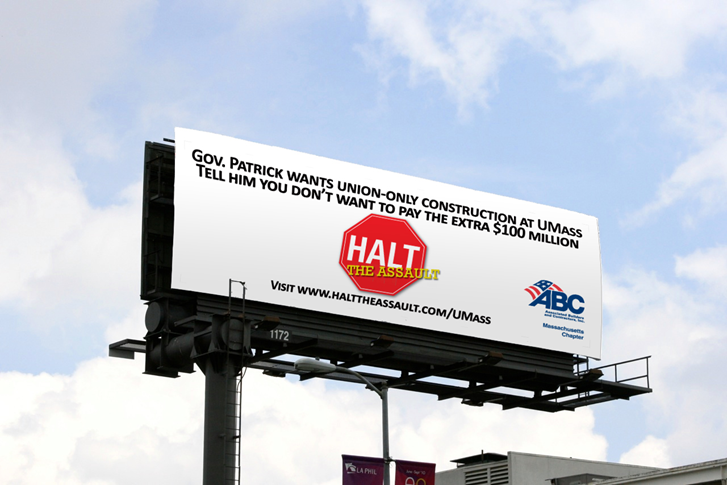Boston Globe: Patrick Shouldn’t Bar Non-Union Workers on Longfellow Bridge
Two taxpayer-funded bridge projects in Mass. illustrates the stark contrast between the benefits of fair and open competition versus anti-competitive and costly government-mandated project labor agreements (PLAs) advanced by well-connected special interests.
The Boston Globe published a scathing editorial opposed to a PLA mandate on the $260 million reconstruction of the Longfellow Bridge in Mass. (“Patrick shouldn’t bar non-union workers on Longfellow Bridge,” 3/30/12):
EDITORIAL | Editorial
March 30, 2012THE PATRICK Administration is pushing ahead with a costly and unfair policy by imposing a project labor agreement on the $260 million reconstruction of the Longfellow Bridge. The administration’s rationale for the agreement, known as a PLA, falls far short of justifying a union-workers-only pact that would put upward pressure on the project price, while effectively excluding the state’s many non-union construction workers and firms from the project.
Last week, Cyndi Roy, director of communications at the Massachusetts Department of Transportation, confirmed that the department will use a PLA on the project if the Federal Highway Administration says okay. The principal reason a PLA is necessary, contends Roy, is that the MBTA’s Red Line runs over the Longfellow Bridge “and there are concerns that contractor employees that are not subject to a PLA mandated no-strike, no-job-action clause could lead to service issues on the Red Line.’’
But disruptive strikes and job actions are not something one commonly associates with non-union firms. Indeed, Greg Beeman, president of Associated Builders and Contractors of Massachusetts, an umbrella group for non-union construction firms, says he can’t recall a single incidence of a strike or job action by a non-union firm on a public job. Asked for examples, Roy failed to provide any, but said, via e-mail, that “there are many instances where union workers have set up picket lines and have disrupted work on non-union contracts.’’
The problem there, however, obviously lies with the union workers, not their non-union counterparts; if that’s really the administration’s big reason for a PLA, then it is letting the prospect of union misbehavior justify excluding non-union firms. That would be an egregiously wrong-headed response.
This is the second PLA that has been imposed under Patrick. The first was on the $750 million renovation and reconstruction of the University of Massachusetts at Boston, which the administration justified by citing the complexity of the project and the need to ensure against disruptive labor disputes.
If those rationales sound rather tinny, well, taxpayers should recall that Patrick pledged to support PLAs on an AFL-CIO endorsement questionnaire when he first ran for governor. And, further, that when he ran for reelection in 2010, he courted trade unions by noting that he had “directed that, going forward, project labor agreements be used when necessary.’’ They are never truly necessary, of course; though the state’s Supreme Judicial Court has said the exclusionary pacts are allowable on certain complex projects, it has also warned that they are anti-competitive.
While the Globe’s editorial is spot-on, it does not address numerous government-mandated PLA projects effected by strikes (some of which are documented in this blog post, Another PLA Myth Busted: PLAs Fail to Prevent Strikes on NYC Projects) despite the main selling point of a PLA is its alleged ability to prevent strikes.
In addition, the editorial does not mention Boston’s Big Dig boondoggle, the poster-child for government-mandated PLA disasters, which you can learn more about at The Most Infamous PLA Job: Lessons From Boston’s Big Dig.
Nor does it hint at the strong likelihood of a PLA mandate soaking taxpayers with additional unnecessary costs. Research on the effect of government-mandated PLAs on Mass. taxpayer-funded school projects conducted by the Beacon Hill Institute at Suffolk University found:
PLAs increase bid costs by $18.83 (or 14%) per square foot. They increase actual construction costs (which often differ slightly from the winning bid) by $16.51 (or 12%) per square foot.
If you are wondering why Gov. Patrick continues to steer lucrative public works projects to his Big Labor cronies, TheTruthAboutPLAs.com addressed political motives in coverage of his UMass PLA scheme here.
A Free Enterprise Bridge to Savings
Meanwhile, MassDOT has a local example of the benefits of free and open competition repairing dilapidated bridges funded by scarce taxpayer dollars. According to a story from GoWorcester Local, the state received considerable cost savings by not mandating a PLA on the $89 million Route 9 Burns Bridge project in Worcester (“Exclusive: Unions Frozen Out of $89M Rt 9 Bridge Project, 3/27/12):
The Middlesex Corp. – a non-union, or merit-shop, based in Littleton – won the contract after bidding $89.8 million, almost $30 million less than the $118 million MassDOT had expected. Two union-based companies, Walsh/Barletta Heavy Joint Venture and White-Skanska Koch Joint Venture, bid $93,392,750 and $119,230,000, respectively.
The article describes Big Labor’s outrage after failing to secure the contract without the help of an anti-competitive PLA mandate, which ensures a monopoly for union members and contractors at the expense of taxpayers and quality nonunion tradespeople and their experienced merit shop contractor employers.

The Route 9 Burns Bridge will be constructed without a PLA at a cost almost 25 percent ($30 million) less than the next responsible bidder.
A spokesperson for the winning bidder, a merit shop contractor, trumpets the benefits of free enterprise:
Bob Mabardy, president of the Northeast Region for Middlesex Corp., took issue with union opposition to the company’s winning bid.
“[Unions] get upset when we get work,” he said. “It’s quite different when their workers get a job. We believe in a free-enterprise system. You shouldn’t have to be in a union to work in the US.”
The lack of a labor agreement in this case, he said, doesn’t change how workers will be hired. Union employees will be among them, he said.
“We pay the prevailing wage, just like unions do” Mabardy said. “It doesn’t matter whether we are an open shop or union. We hire union subcontractors all the time. If they’re low and qualified, they will get the work.”
It’s time for the Patrick Administration to give government-mandated PLAs the heave-ho. Taxpayers deserve savings through fair and open competition, not special interest handouts at the expense of everyone else.














One Response to Boston Globe: Patrick Shouldn’t Bar Non-Union Workers on Longfellow Bridge
[…] http://thetruthaboutplas.com/2012/03/30/boston-globe-patrick-shouldnt-bar-non-union-workers-on-longf… […]